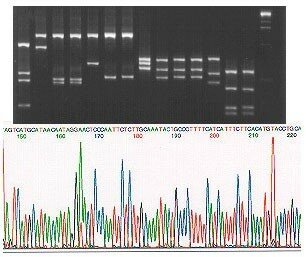
Population genetics is the quantitative study of the frequencies of alleles and genotypes in populations and the change of these frequencies over time and space. Factors that cause adaptive genetic changes in populations in response to their environment also drive evolution. The degree and pattern of genetic variation vary among organisms. Populations of most plant species, especially conifer trees, show extensive genetic variation among individuals. Population genetic analysis aims at unveiling the role of evolutionary forces such as selection, drift, mutation, gene exchange, introgression, mating system, and migration history in shaping the organization of genetic variability in plant populations. The detection of alleles and genotypes is based on the use of various markers, such as allozymes, nuclear and cytoplasmic DNA RFLPs, microsatellites, and direct DNA sequence analysis. These techniques provide codominant markers that can be used in estimatingpopulation genetic parameters such as population genetic structure, outcrossing rate, population subdivision, gene migration, cyto-nuclear gene disequilibrium, and departure from Hardy-Weinberg equilibrium. Sequence variation analysis for the coding sequences provides insights into the molecular basis of allelism and the adaptive potential of different alleles. We are studying the evolution of a Pinus species complex from Eurasia by means of allozyme and cpDNA markers.

By analyzing nuclear and chloroplast DNA variation and patterns of gene exchange, the study has provided for the first time genetic evidence for an ancient hybrid origin of Pinus densata native to the Tibetan plateau. The genetic structure of a population is to a large extent defined by spatial structure. In organisms with a mixed mode of reproduction, the observed population structure represents the outcome of both sexual and asexual reproduction as well as the prevalent dispersal mechanism. Population studies of any organism with mixed modes of reproduction rely heavily on the ability to unambiguously identify sexually produced individuals and asexually produced clones. Highly polymorphic molecular markers can be applied at these levels with great reliability, and they allow simultaneous measurement of variability at multiple loci in each individual tested. Using these markers, we are conducting fine scale population structure analysis of a fungal conifer pathogen,Gremmeniella abietina. The study has revealed high levels of genetic variability in strains of the fungus even within local host stands. Gametic disequilibrium tests have indicated high degrees of sexual reproduction, which increases the population variability. The spatial distribution of genotypes showed very limited dispersal of clones and each host was infected by multiple fungus genotypes. For microorganisms such as plant pathogenic fungi, information on the genetic variability and the population dynamics have important potential practical applications in, for instance, predicting the pathogen═s development, and adjusting breeding and disease control strategies. The amount of genetic variation being maintained within a population may indicate how rapidly a pathogen can evolve and adapt to changing environments. In summary, our activities in this research category focus on the development of different types of molecular markers and their application in studies on: ┴ Mating system and population genetic structure of conifer trees over a wide range of geographic regions. ┴ Genetics of diploid speciation in Pinus and the evolutionary significance of gene exchange in the formation of new species. ┴ fungal conifer pathogens and host-pathogen interactions. ┴ Population genetics of clonal plants. ┴ The molecular basis of allelism in Pinus sylvestris populations and its adaptive significance.
Selected publications:
Szmidt, A. E., Wang, X-R. () Molecular systematics and patterns of geographic differentiation in geographic varieties of Pinus sylvestris (L.) and P. densiflora (Sieb. et Zucc). TAG 86: 159-165.
Wang, X-R. and Szmidt, A.E. () Hybridization and chloroplast DNA variation in a Pinus species complex from Asia. Evolution 48: .
Parducci, L., Szmidt, A.E., Villani, F., Wang, X-R. and Cherubini, M. () Genetic variation of Abies alba (Mill.) in Italy. Hereditas 125: 11-18.
Wang, X-R. () Genetic variability in the canker pathogen fungus, Gremmeniella abietina (Lagerb.) Morelet. Contribution of sexual compared to asexual reproduction. Mycol. Res. 101:.
Wang, X-R., Ennos, R.A., Szmidt, A.E. and Hansson, P. () Genetic variability in the canker pathogen fungus, Gremmeniella abietina (Lagerb.) Morelet. 2. Fine scale investigation of population structure. Can. J. Bot. 75:.
Wang, X-R. and Szmidt, A. E. () Population genetic analysis of pathogenic forest fungi. In: Molecular Biology of Woody Plants, Jain, S.M. (ed), Kluwer Academic Publisher.
|